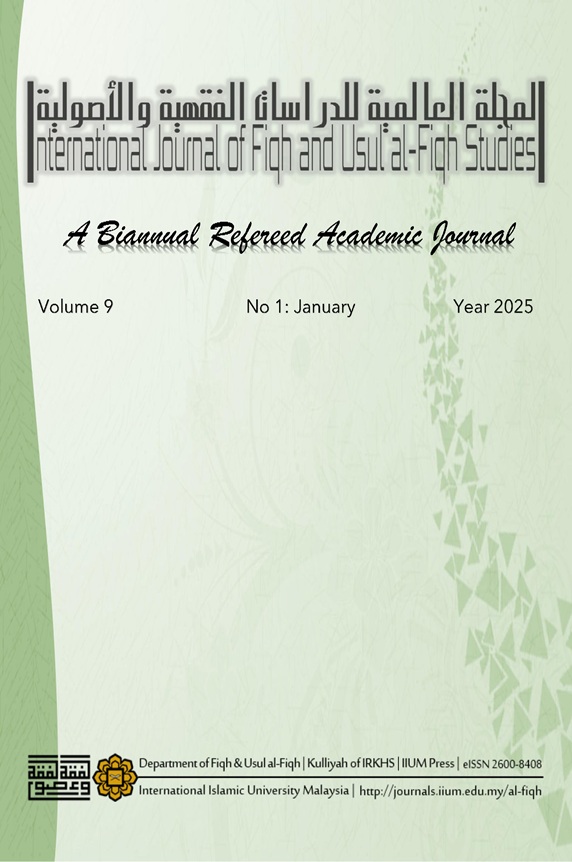Matrimonial Property Rights: An Analytical and Comparative Study between Ugandan Civil Law and Islamic Law
DOI:
https://doi.org/10.31436/ijfus.v9i1.361Keywords:
Matrimonial property, Court of Appeal, Shariah Court, Ugandan law, Islamic lawAbstract
This research explores the trends in conceptualizing the matrimonial property in both statutory and Islamic laws in Uganda. Judges in both civil and Shariah courts have deliberated extensively on this concept, considering various socio-economic factors when determining what constitutes matrimonial property and the criteria for its distribution upon the dissolution of marriage. A qualitative study approach was employed to review both substantive and case laws, aiming to reveal the judges’ considerations regarding what constitutes matrimonial property and the basis for determining its distribution upon the dissolution of marriage. Data were collected through observation, in-depth study, and analysis of written materials reflecting the theoretical concepts used in this study. The study concludes that the concept of matrimonial property has developed gradually. Although secular and Islamic laws have taken different approaches to recognize it, both regimes acknowledge the woman’s contribution to matrimonial property. Consequently, they emphasize equity rather than equality in determining the shares upon the dissolution of marriage.
Downloads
Metrics
References
Al-Bukhārī, M. (2002). Ṣaḥīḥ al-Bukhārī. Dār Ibn Kathīr.
Al-Jamal, S. (n.d.). Ḥāshiyat al-Jamal ʿalā sharḥ al-minhāj. Dār Iḥyāʾ al-Turāth al-ʿArabī.
All England Law Reports. (1969).
Al-Maqdisī, A. (1992). Al-mughnī. Dār al-Hijrah.
Al-Mardāwī, A. (1957). Al-inṣāf fī maʿrifat al-rājiḥ min al-khilāf ʿalā madhhab al-Imām Aḥmad ibn Ḥanbal. [Publisher not specified].
Al-Māwardī, A. (n.d.). Al-ḥāwī al-kabīr. Dār al-Fikr.
Al-Sarakhsī, M. (1993). Al-mabsūṭ. Dār al-Maʿrifah.
Al-Shirbīnī, M. (1994). Mughnī al-muḥtāj ilā maʿrifat maʿānī alfāẓ al-minhāj. Dār al-Kutub al-ʿIlmiyyah.
Al-Shirbīnī, M. (1994). Mughnī al-muḥtāj ilā maʿrifat maʿānī alfāẓ al-minhāj (1st ed.). [Publisher not specified].
Al-Zuḥaylī, W. (1987). Al-tafsīr al-munīr fī al-ʿaqīdah wa-al-sharīʿah wa-al-manhaj. Dār al-Fikr.
Al-Zuḥaylī, W. (n.d.). Al-fiqh al-Islāmī wa-adillatuhu. Dār al-Fikr.
Awino, M. A. (2013). The concept of matrimonial property: A case study of Uganda.
Birungi, I. (2017). Critical analysis of the legal and institutional framework regarding matrimonial property in Uganda. Kampala International University.
Eletrebi, M. F. M., & Suleiman, H. (2021). Al-takyīf al-fiqhī of matrimonial property in Islamic jurisprudence. Linguistics and Culture Review, 5(S4), 2195-2202. https://doi.org/10.21744/lingcure.v5nS4.1917
Ibn ʿĀbidīn, M. A. (1987). Ḥāshiyat radd al-muḥtār ʿalā al-durr al-mukhtār. [Publisher location missing].
Ibn Nujaym, Z. (n.d.). Al-baḥr al-rāʾiq sharḥ kanz al-daqāʾiq. Dār al-Maʿrifah.
Islamic Fiqh Council. (n.d.). Resolution 144.
Mālik ibn Anas. (1994). Al-mudawwanah. Dār Iḥyāʾ al-Turāth al-Islāmī.
Mohamed, W. A., & Abdul Halim, M. M. (2012). The concept of matrimonial property: Conditions and regulations. Linguistics and Culture Review, 5(S4), 2203-2210. https://doi.org/10.21744/lingcure.v5nS4.1932
Sahid, M. M. (2016). Sharʿiyyat al-māl al-mushtarak bayna al-zawjayn. Majallat al-Sharīʿah wa-al-Qānūn, 4. USIM.
Sharmin, S. S., & Azad, M. M. (2018). Laws of Muslim marriage from the concept of the Holy Qur'an. International Journal of Engineering and Applied Sciences.
Legal References:
Black’s Law Dictionary
Christopher Mbaziira (2013) The Status of Economic, Social and Cultural Rights in Uganda: The Huge Potential, Economic and Social Rights Advocacy ‘(ESRA’ Brief”.
Convention on the Elimination of All Forms of Discrimination against Women, 1981.
East African Law Reports [1990 – 1994]
Haleema Sadia, Rukhsana Waraich and Sadia Halima (2023), CEDAW & Woman’s Right to Work in Islamic Law, Journal of Social Sciences and Humanities.
High court law reports.Kenya Law Reports.
International Covenant on Economic, Social and Cultural Rights, 1966.
Islamic Family Law (Federal Territories) Act 1984, Malaysia
Islamic Family Law (State of Selangor) Enactment 2003.
Maputo Protocol to the African Charter on Human and People’s Rights on the Rights of Women in Africa, 2003
Mohamed, W. M. A., & Halim, M. M. A. (2021). The concept of matrimonial property: Conditions and regulations. Linguistics and Culture Review, 5(S4), 2203-2210. https://doi.org/10.21744/lingcure.v5nS4.1932, Malaysia.
The 1995 Constitution of the Republic of Uganda as amended.
The Hague Institute for Innovation of Law (HiiL) Report 2020.
Case Law:
Ambayo Joseph Waigo Versus Aserua Jackline, Civil Appeal No. 0100 of 2015- 2022.
Ayiko Vs Lekuru Divorce Cause No. 1 of 2015
Bashaar V. Aminata, Civil Suit no. 076 of 2022.
Herbert Kolya Vs Ekiriya Kolya Civil Suit No. 150 of 2016.
Julius Rwabinumi Vs. Hope Bahimbisomwe, Civil Appeal NO. 10. Of 2009.
Kagga v. Kagga, High Court Divorce Cause No. 11 of 2005, (unreported).
Kayhu vs Kayhu, Divorce Cause No. 123 of 2106.
Kivuitu v. Kivuitu, East African, 1990 – 1994, 270.
Mayambala v Mayambala, High Court Divorce Cause No. 3 of 1998.
Muthembwa v Muthembwa, East Africa 2002, 186.
Muwanga v. Kintu, High Court Divorce Appeal No. 135 of 1997, (Unreported).
Sarah Kiyemba vs. Robert Batte, Divorce Cause No. 127 of 2018.
Sempiga v Sempiga Musajjawaza, High Court Divorce Cause No. 007 of 2005 (Unreported).
Uhiriwe Peace vs Kuuku Kagwa Paul and 2 others, Divorce Cause No. 118 of 2017.
UMI v UMI, Kenya Law Reports, 2012.
Downloads
Published
How to Cite
Issue
Section
License
Copyright (c) 2025 International Journal of Fiqh and Usul al-Fiqh Studies

This work is licensed under a Creative Commons Attribution-NonCommercial 4.0 International License.
The IIUM journal follows the open access policy.
Consent to publish: The Author(s) agree to publish their articles with IIUM Press.
Declaration: The Author(s) declare that the article has not been published before in any form and that it is not concurrently submitted to another publication, and also that it does not infringe on anyone’s copyright. The Author(s) holds the IIUM Press and Editors of the journal harmless against all copyright claims.
Transfer of copyright: The Author(s) hereby agree to transfer the copyright of the article to IIUM Press, which shall have the exclusive and unlimited right to publish the article in any form, including in electronic media. However, the Author(s) will reserve the right to reproduce the article for educational and scientific purposes provided that the written consent of the Publisher is obtained. For the article with more than one author, the corresponding author confirms that he/she is authorized by his/her co-author(s) to grant this transfer of copyright.
























